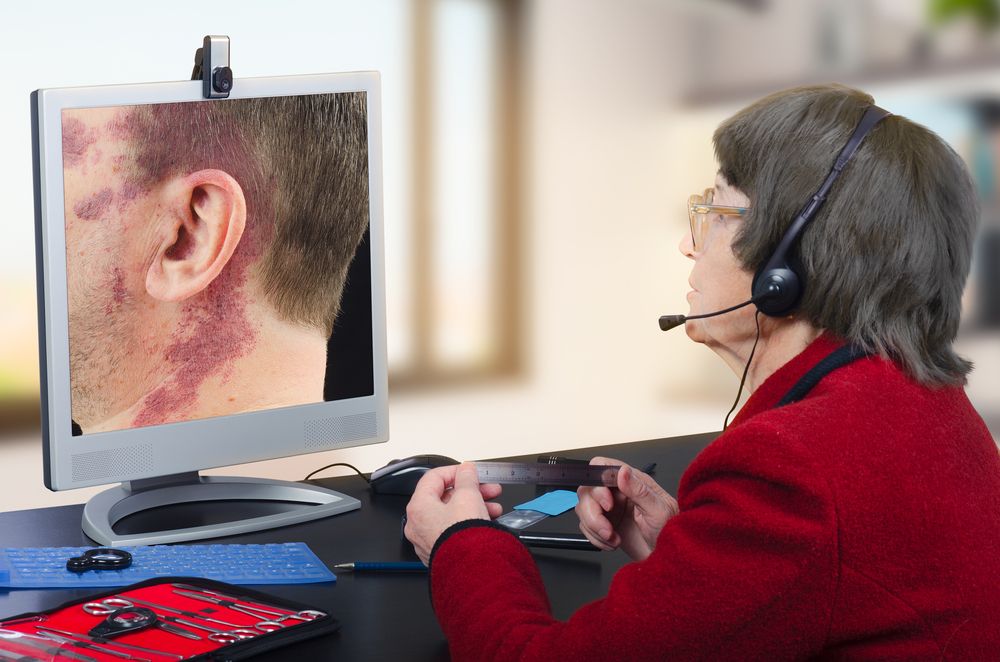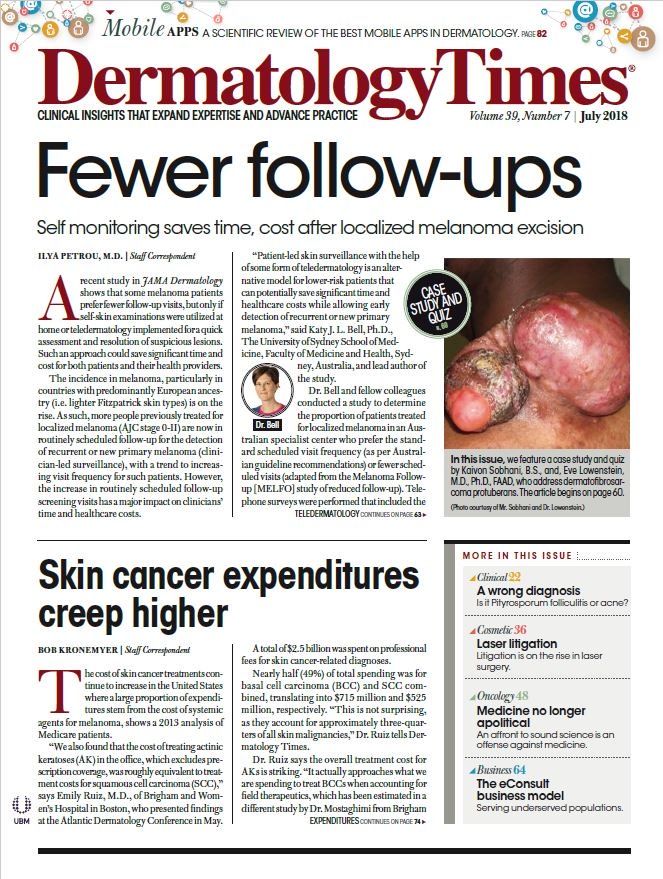- Case-Based Roundtable
- General Dermatology
- Eczema
- Chronic Hand Eczema
- Alopecia
- Aesthetics
- Vitiligo
- COVID-19
- Actinic Keratosis
- Precision Medicine and Biologics
- Rare Disease
- Wound Care
- Rosacea
- Psoriasis
- Psoriatic Arthritis
- Atopic Dermatitis
- Melasma
- NP and PA
- Skin Cancer
- Hidradenitis Suppurativa
- Drug Watch
- Pigmentary Disorders
- Acne
- Pediatric Dermatology
- Practice Management
- Prurigo Nodularis
- Buy-and-Bill
Publication
Article
Dermatology Times
eConsults support underserved patients
Author(s):
Study shows how primary care and dermatology practices can collaborate to serve underserved populations.
(©Verbaska/Shutterstock.com)

Electronic consultations with dermoscopy increased access, reduced wait times and identified several skin cancers that might have otherwise gone undiagnosed among underserved patients at community health centers, shows a study published earlier this year in the Journal of the American Academy of Dermatology.
Electronic consultations, also known as eConsults, have been shown to improve patient access to dermatology and other specialty care. This study looked specifically at the impact of teledermatology with use of dermoscopy for Medicaid and uninsured patients in Connecticut who sought primary care at community health centers.
The study provides a model for how primary care and dermatology practices can collaborate to offer teledermatology services â with dermoscopy â to these underserved populations.
ACCESS HURDLES
Less than half of patients referred to dermatologists from primary care providers receive appointments. Medically underserved patients, such as those on Medicaid, are even less likely to get appointments with specialty providers. For example, less than 40% of dermatologists in Connecticut where the study was conducted, accept new Medicaid patients. Nationally, Medicaid patients have been shown to wait 38% longer than Medicare or private insurance patients for appointments.
Researchers looked retrospectively at 2,385 dermatology referrals from a large, multisite federally qualified health center in Connecticut. More than 60% of the more than 140,000 patients who receive comprehensive primary care services from the center are minorities and more than nine out of 10 are at or below 200% of the federal poverty Level. Most have state-funded Medicaid insurance.
eCONSULT ELEMENTS, OUTCOMES
For the teledermatology intervention, each primary care practice received a camera and dermatoscope. Two dermatologists from the UConn Health Center reviewed eConsults for the study. And the Connecticut Department of Social Services reimbursed providers for the eConsults provided to Medicaid patients.
Primary care providers could send eConsults to dermatologists for review or bypass the teledermatology option and request a traditional in-person referral. Dermatologists reviewing the eConsults weren’t necessarily the same dermatologists who saw patients for face-to-face appointments.
“Dermatologists act as consulting physicians who provide consultation in terms of diagnosis and management plan. It’s the primary care physician’s responsibility to implement the plans,” study author Jun Lu, M.D., a dermatologist at UConn Health, Farmington, Conn., told Dermatology Times via email. “If the patients need to come in for face-to-face visits, the consulting dermatologists help to provide easy and quick access although patients could choose to go to other providers.”
Dr. Lu explains that to guarantee the quality of referrals, she and colleagues provided referring providers and their staffs with video and real-time tutorials and training on how to submit a dermatology-focused history and relevant information, how to take high-quality photos and how to use dermoscopy to take photos.
Researchers compared results six months before implementing the teledermatology eConsults to six months after implementation.
Before eConsult implementation 11% of 1,258 referrals to dermatologists resulted in confirmed appointments, with an average wait time of 77 days. After implementation, 44% of 1127 consults were electronically sent and all received dermatology consultations within less than 24 hours on average. Of those, 16% required a face-to-face visit with a dermatologist, with an average wait time of 28 days. Meanwhile, only 16.3% of the patients who chose traditional face-to face appointment received care with average waiting time of 104 days. Dermatologists diagnosed a spectrum of cutaneous conditions with the eConsults, from dermatitis, to acne, benign neoplasms, psoriasis, pigmentation disorders, alopecia and suspicious neoplasms.
All 29 patients who had suspicious neoplasms on eConsults received dermatology appointments. Ten of those were no-shows. Of the 15 patients who had face-to-face appointments, all were biopsied and 10 had malignancies, including either basal cell or squamous cell carcinomas.
Of the 60 primary care providers who participated in the study, 39 responded to questions about their satisfaction with the intervention. Eighty-five percent were satisfied or very satisfied with eConsults, while, 2.9%, or one of the providers, reported being dissatisfied.
IMPLICATIONS
The study suggests dermatology eConsults can be done on a large scale within a network of primary care providers who are free to decide whether or not to use eConsults. And they can be done where dermatologists who review the eConsults are not necessarily the dermatologists who see patients face-to-face.
The author writes that previous research has shown these eConsult elements help reduce face-to-face appointments: patient selection; high-quality image production; dermoscopy use; and an effective infrastructure. This intervention resulted in a substantial reduction of in-person visits by including not only these elements but also protocols for which consults to electronically submit and image acquisition training.
“We made it clear that patients with history of skin cancers or dysplastic nevi that need full-body skin examination are not good candidates for teledermatology. These patients need face-to-face visits,” Dr. Lu writes.
An important benefit to providers is eConsults might reduce no-shows in the medically-underserved population, which has been shown to have especially high no-show rates.
Still, these findings might not be generalizable to all patients in all settings. Non-Medicaid populations may see e-Consults as undesirable, as they don’t experience the same access issues, according to the authors. And reimbursement for teledermatology isn’t universal, but that’s improving. The success of this program led Connecticut to pass legislature allocating Medicaid funding to cover teledermatology service, according to Dr. Lu. She and her colleagues also have been contacted by private insurers interested on similar collaborations, she writes.
There are different models and platforms available for teledermatology, Dr. Lu said.
“The ultimate goal is to provide high-quality care to patients in need. Therefore, it’s very important to have full access to complete medical histories, including medication and allergy [information]. It’s also very important to have a system set up in a way to guarantee patients easy access to face-to-face evaluation or treatment if needed,” she writes. “…teledermatology should be part of comprehensive coordinated care, rather than a curbside consult.”
REFERENCES
Naka F, Lu J, Porto A, Villagra J, Wu ZH, Anderson D. Impact of dermatology eConsults on access to care and skin cancer screening in underserved populations: A model for teledermatology services in community health centers. J Am Acad Dermatol. 2018 Feb;78(2):293-302. DOI:10.1016/j.jaad.2017.09.017







